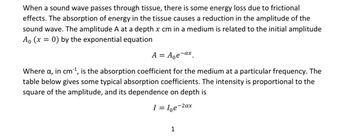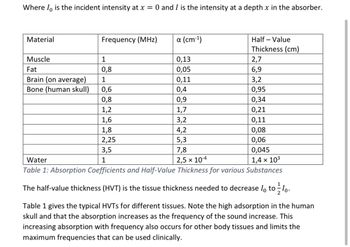
Elements Of Electromagnetics
7th Edition
ISBN: 9780190698614
Author: Sadiku, Matthew N. O.
Publisher: Oxford University Press
expand_more
expand_more
format_list_bulleted
Question
In table 1, a comparison between different frequencies on bone is made. Which is better, a higher or lower frequency? Why?

Transcribed Image Text:When a sound wave passes through tissue, there is some energy loss due to frictional
effects. The absorption of energy in the tissue causes a reduction in the amplitude of the
sound wave. The amplitude A at a depth x cm in a medium is related to the initial amplitude
Ao (x = 0) by the exponential equation
A = A₂e-ax.
Where a, in cm³¹, is the absorption coefficient for the medium at a particular frequency. The
table below gives some typical absorption coefficients. The intensity is proportional to the
square of the amplitude, and its dependence on depth is
I = = loe-2ax
1

Transcribed Image Text:Where I is the incident intensity at x = 0 and I is the intensity at a depth x in the absorber.
Material
Frequency (MHz)
Muscle
1
Fat
0,8
Brain (on average)
1
Bone (human skull) 0,6
0,8
a (cm-¹)
0,13
0,05
0,11
0,4
0,9
1,7
3,2
4,2
5,3
7,8
2,5 x 10-4
Half - Value
Thickness (cm)
2,7
6,9
3,2
0,95
0,34
1,2
0,21
1,6
0,11
1,8
0,08
2,25
0,06
3,5
0,045
Water
1
1,4 × 10³
Table 1: Absorption Coefficients and Half-Value Thickness for various Substances
The half-value thickness (HVT) is the tissue thickness needed to decrease lo tolo.
Table 1 gives the typical HVTs for different tissues. Note the high adsorption in the human
skull and that the absorption increases as the frequency of the sound increase. This
increasing absorption with frequency also occurs for other body tissues and limits the
maximum frequencies that can be used clinically.
Expert Solution
This question has been solved!
Explore an expertly crafted, step-by-step solution for a thorough understanding of key concepts.
Step by stepSolved in 5 steps with 23 images

Knowledge Booster
Similar questions
- Does the maximum distortion energy theory depend on the strain energy? why?arrow_forwardListed below are four categories (i.e., types) of defects. Give one example for each type of defect and briefly describe what it is. 0-D Point Defects 1-D Line Defects 2-D Planar Defects 2-D Volume Defectsarrow_forwardA silicon carbide rotor fractures at a stress level of 100 MPa. This material has a fracture toughness of 4 MPa(m)1/2. Estimate the external flaw size responsible for this behavior with a geometric factor of f = 1.12. Report your size in mm from the options below. 0.4 mm 0.406 mm 10 mm 1 mmarrow_forward
- Define mechanical observation. Two devices that do not need direct participation.arrow_forwardChanges in cortical bone density and bone geometry occur with aging in both men and women (Table 1 from Russo 2003). These changes manifest as decreased bone strength, which has the clinical impact of increasing the risk of fracture with increasing age. However, elderly men are much less prone to fracture than elderly women. It has been suggested that age-related bone loss is the consequence of endosteal bone resorption resulting in changes in bone geometry (~2mm less cortical bone thickness in women as they age) and contributing to relative differences in fracture risk between men and women. Cortical bone area decreases in women between the ages of 20 and 85, whereas there is no significant change in cortical bone area for men over the same age range (Table 1). Table 1: Changes in bone density and cortical bone area - from Italian population of 612 men and 693 women Age group (years) ANOVA 20-39 Total bone density 4% (mg/cm³) Men Women Cortical bone area 38% (mm²) Men 318.9±47.9 Women…arrow_forwardwhat is this material made ofarrow_forward
arrow_back_ios
arrow_forward_ios
Recommended textbooks for you
 Elements Of ElectromagneticsMechanical EngineeringISBN:9780190698614Author:Sadiku, Matthew N. O.Publisher:Oxford University Press
Elements Of ElectromagneticsMechanical EngineeringISBN:9780190698614Author:Sadiku, Matthew N. O.Publisher:Oxford University Press Mechanics of Materials (10th Edition)Mechanical EngineeringISBN:9780134319650Author:Russell C. HibbelerPublisher:PEARSON
Mechanics of Materials (10th Edition)Mechanical EngineeringISBN:9780134319650Author:Russell C. HibbelerPublisher:PEARSON Thermodynamics: An Engineering ApproachMechanical EngineeringISBN:9781259822674Author:Yunus A. Cengel Dr., Michael A. BolesPublisher:McGraw-Hill Education
Thermodynamics: An Engineering ApproachMechanical EngineeringISBN:9781259822674Author:Yunus A. Cengel Dr., Michael A. BolesPublisher:McGraw-Hill Education Control Systems EngineeringMechanical EngineeringISBN:9781118170519Author:Norman S. NisePublisher:WILEY
Control Systems EngineeringMechanical EngineeringISBN:9781118170519Author:Norman S. NisePublisher:WILEY Mechanics of Materials (MindTap Course List)Mechanical EngineeringISBN:9781337093347Author:Barry J. Goodno, James M. GerePublisher:Cengage Learning
Mechanics of Materials (MindTap Course List)Mechanical EngineeringISBN:9781337093347Author:Barry J. Goodno, James M. GerePublisher:Cengage Learning Engineering Mechanics: StaticsMechanical EngineeringISBN:9781118807330Author:James L. Meriam, L. G. Kraige, J. N. BoltonPublisher:WILEY
Engineering Mechanics: StaticsMechanical EngineeringISBN:9781118807330Author:James L. Meriam, L. G. Kraige, J. N. BoltonPublisher:WILEY

Elements Of Electromagnetics
Mechanical Engineering
ISBN:9780190698614
Author:Sadiku, Matthew N. O.
Publisher:Oxford University Press

Mechanics of Materials (10th Edition)
Mechanical Engineering
ISBN:9780134319650
Author:Russell C. Hibbeler
Publisher:PEARSON

Thermodynamics: An Engineering Approach
Mechanical Engineering
ISBN:9781259822674
Author:Yunus A. Cengel Dr., Michael A. Boles
Publisher:McGraw-Hill Education

Control Systems Engineering
Mechanical Engineering
ISBN:9781118170519
Author:Norman S. Nise
Publisher:WILEY

Mechanics of Materials (MindTap Course List)
Mechanical Engineering
ISBN:9781337093347
Author:Barry J. Goodno, James M. Gere
Publisher:Cengage Learning

Engineering Mechanics: Statics
Mechanical Engineering
ISBN:9781118807330
Author:James L. Meriam, L. G. Kraige, J. N. Bolton
Publisher:WILEY